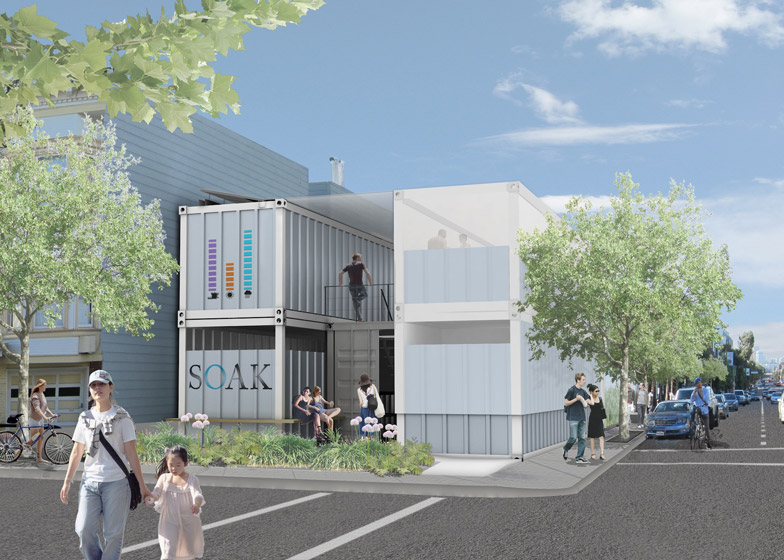News: wellness entrepreneur Nell Waters is attempting to raise £146,000 on crowdfunding website Kickstarter to build a prototypal ecological urban bathhouse from shipping containers in San Francisco.
Waters wants to create an "urban bathhouse for healthy hedonists" that could pop up on any available lot in the city and operate autonomously from the municipal power and water supplies.
The design of the SOAK spa was developed by San Francisco design studio Rebar, and consists of stacked containers arranged around a courtyard that house changing rooms, toilets, a lounge, a sauna, hot tubs and a roof deck.
"This container-spa joins the wave of tactical urbanism currently happening in San Francisco and other cargotecture projects that have created a local zeitgeist around the recognisably corrugated exterior," said the project team in a statement. "No city is better positioned to launch this first iteration of the mobile, pop-up spa."
A small garden next to the entrance would lead to an internal courtyard housing the reception, enclosed showers and two cold plunge buckets. Stairs would provide access to the roof lounge and an additional hot tub.
Rainwater would provide half of the spa's water, while greywater would be filtered through plants and particle filers and used to irrigate a garden on the rear patio. All of the water used would be heated by solar hot water heaters and photovoltaic panels on the roof.
"The challenge that we set out in developing this proof of concept prototype is to use absolutely the least amount of water possible, use the least amount of energy possible - we try to catch as much as we can from the sky," explained Blaine Merker from Rebar in a video on the project's Kickstarter page.
The project team has engaged engineers to analyse the spa's energy performance and, if it achieves its funding target by 1 January 2014, will work on refining the structural criteria of the containers and assessing water usage with the aim of realising a two-container prototype sometime in 2014.
More details from the project's co-ordinators follows:
Soak - an urban bathhouse for healthy hedonists
Designed to be modular and self-contained, the urban bathhouse called SOAK identifies with a changing urban landscape and literally pops-up where there is interim use for creative activity, simultaneously taking advantage of lower real estate costs and incubating activity in up-and-coming neighbourhoods. With its unique anti-spa ethos, SOAK creates an experiential bridge between the ancient practice of ritual ablutions and a modern approach to wellness that makes "soaking" a social practice.
SOAK provides a dynamic space for personal wellness, connected experiences, and healthy hedonist gatherings. Built from repurposed shipping containers, the structure of SOAK helps reframe an answer to the question: what is wellness? In part, SOAK's aim is to change the way we think about water-intensive day spas, instead substituting a creatively designed ecological bathhouse for a modern, urban environment. This container-spa joins the wave of tactical urbanism currently happening in San Francisco and other cargotecture projects that have created a local zeitgeist around the recognisably corrugated exterior. No city is better positioned to launch this first iteration of the mobile, pop-up spa.
Inspired by saunas in Amsterdam, Japanese bathing culture, and San Francisco's former Sutro Baths, SOAK's founder, Nell Waters, consulted designers about building a truly ecological urban bathhouse. Was there a way to scale back the opulent use of natural resources? Could they redefine the meaning of wellness through the materials used? Could social interaction replace meditative silence? At SOAK, sustainability, sociability, and healthy hedonism are the guiding principles.
Its structure demonstrates its flexibility. Two shipping containers surround an interior courtyard, one housing the changing facilities, lounge and restrooms, the other housing the hot tubs, a roof deck and sauna. The bathhouse seamlessly transitions between interior space and garden, inviting visitors to soak in the heat, cool off under a cold plunge bucket in the garden, rest among the plants, and lounge with a view of the city on the roof deck. Greywater from hot tubs, sinks and showers is collected and filtered through surge tanks, purifying plants and particle filters. Filtered water is then used to irrigate the siteʼs permanent garden.
Take the urban bathhouse concept to its extreme, and you get SOAK: a pop-up spa inside of shipping containers. Mobile, autonomous, and sleek. One step further and you get something more. An urban bathhouse for healthy hedonists. SOAK hired the San Francisco based Rebar Design Studio and principal Blaine Merker to design the urban bathhouse because of their smart creative process, and award winning reputation.

